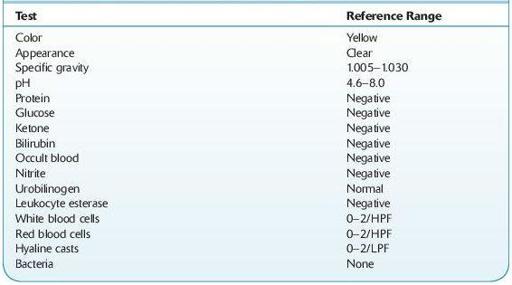Wallach's Interpretation of Diagnostic Tests: Pathways to Arriving at a Clinical Diagnosis (1276 page)
Authors: Mary A. Williamson Mt(ascp) Phd,L. Michael Snyder Md

BOOK: Wallach's Interpretation of Diagnostic Tests: Pathways to Arriving at a Clinical Diagnosis
4.42Mb size Format: txt, pdf, ePub
TABLE 16–81. Reference Values for Urinalysis

Use
Frequently performed screening test for metabolic and kidney disorders and for UTIs.
Interpretation
For specific causes of increased and decreased values of constituents, see individual tests.
Limitations
See Table 16.82.
TABLE 16–82. Interferences Which May Cause False-Positive or False-Negative Test Results

Suggested Reading
Brunzel NA.
Fundamentals of Urine and Body Fluid Analyses
, 2nd ed. Philadelphia, PA: Saunders; 2004.
URINE PROTEIN ELECTROPHORESIS/IMMUNOFIXATION
Definition
Urine protein electrophoresis (UPEP) is analogous to the serum protein electrophoresis test and is used to detect monoclonal proteins (M-proteins) in the urine by an electrophoretic method. A 24-hour urine collection is necessary for determination of the total amount of protein excreted in the urine per day. The quantity of M-protein excreted is determined by measuring the size (percent) of the M-spike in the densitometer tracing and multiplying it by the total 24-hour urinary protein excretion. The amount of protein can be expressed as mg/dL or mg/L, but it is much more useful to report the M-protein in g/24 hours because of wide variability in the daily urinary volume. On UPEP, a urinary M-protein is seen as a dense localized band on agarose or a tall narrow peak on the densitometer tracing. Generally, the amount of urinary monoclonal protein correlates directly with the size of the plasma cell burden, as long as renal function is relatively normal. Other names: Bence-Jones protein test.

Normal range:
negative or no monoclonal free light chains detected.
Use
All patients with a diagnosis of a plasma cell dyscrasia should have a baseline UPEP (and immunofixation) of an aliquot from a 24-hour urine collection. This test is essential for detection of the presence of potentially nephrotoxic concentrations of urinary light chains.
Other books
Full Throttle Yearning by Lynn, Aurora Rose
Billionaire's Christmas Vixen by Nelson, Cara
The Atlantis Code by Charles Brokaw
Loved by a SEAL by Cat Johnson
House of Payne: Steele by Stacy Gail
The Brink by Pass, Martyn J.
Fear Familiar Bundle by Caroline Burnes
Come Rain or Shine by Allison Jewell
Tainted Bride by A.S. Fenichel
The Phoenix Land by Miklos Banffy
